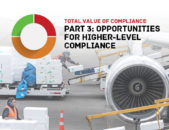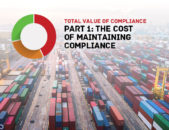The long-awaited DOT PHMSA Interim Final Rule (IFR) enhancing the safety provisions for lithium batteries transported by aircraft appeared in the Federal Register this week on March 6th. This IFR generally harmonizes the 49 CFR with the ICAO Technical Instructions for the Safe Transport of Dangerous Goods by Air (regulations effective in the ICAO TI…
Total value of compliance, Part 3: Creating new revenue from DG compliance
Managing a Dangerous Goods shipping operation is a lot like running a farm. It may seem like all you do is spend money, while the potential profits are hard to imagine—and a long way off. But if a farmer makes every decision with that long term in mind, the operation is much more likely to…
Total value of compliance, Part 2: What do compliance gaps actually cost you?
Every hazmat pro knows a Dangerous Goods shipment that doesn’t comply with current regulations could end up costing their company money. In fact, 28% of hazmat pros surveyed in our 2018 Global Dangerous Goods Confidence Outlook said their companies comply with regulations only because the regulations mandate it. In other words, all they want to…
Total value of compliance, Part 1: Assessing your hazmat processes and procurement
Trick question: Do you spend too much on Dangerous Goods compliance? Most hazmat professionals would probably answer “yes.” Whenever we have to spend money on something that doesn’t show an immediate benefit, it always feels like we’re spending too much. And there’s no getting around it—Dangerous Goods compliance requires a financial outlay. But the real…
How a free Total Value of Compliance Assessment can make your hazmat operation more profitable
Late last year, we introduced a new concept to the Dangerous Goods galaxy: total value of compliance. It’s a new way of thinking about supply chain operations that views hazmat compliance as not just a cost of doing business, but also as a value-added component that contributes to profitability. Maybe you read that post, and…
11 must-have items for hazmat shipping when your eyelashes freeze
Happy New Year! For those of us in northern climes, we’re well past the isn’t-winter-wonderful? phase and well into the enough-already-with-the-freezing-rain phase. Yet Dangerous Goods shipments don’t care if your eyelashes freeze together or your fingertips go numb. Your customers and supply chain partners still expect your shipments to be safe, compliant and on time,…
2018: The year in Dangerous Goods regulations
2018 was a relatively quiet year in the Dangerous Goods galaxy, with few major new regulatory changes and no unexpected surprises from domestic or international regulatory bodies. Still, as Labelmaster’s Manager of Regulatory Affairs and Corporate Responsibility, I hear all the questions from our customers and partners about how best to comply with regulations. This…
Total value of compliance, as explained by Chicago Bears fans
Lots of us at Labelmaster are excited about our hometown Chicago Bears, who are poised to make the National Football League playoffs for the first time in eight years. As one of the league’s biggest turnaround stories, the Bears have made sharp improvements in several statistical categories. One improvement that gets very little attention? Penalty…
How CEVA’s Rusty McMains makes the C-Suite pay attention to hazmat
In today’s supply chain, the way people think about Dangerous Goods transport is evolving. It used to be common for organizations to view hazmat compliance as a necessary evil—just a cost of doing business. They cared about safety, and they cared about avoiding delays and civil penalties, but that was the extent of their concern.…
Why “total value of compliance” is a new paradigm for hazmat shippers
Why do you pursue Dangerous Goods compliance? Take a moment before you answer, because the real reason may not be as obvious as you think. We’ve been asking hazmat professionals that question for years, and the answers have evolved. Today, nearly a quarter of companies in the DG supply chain pursue compliance because it’s a…








